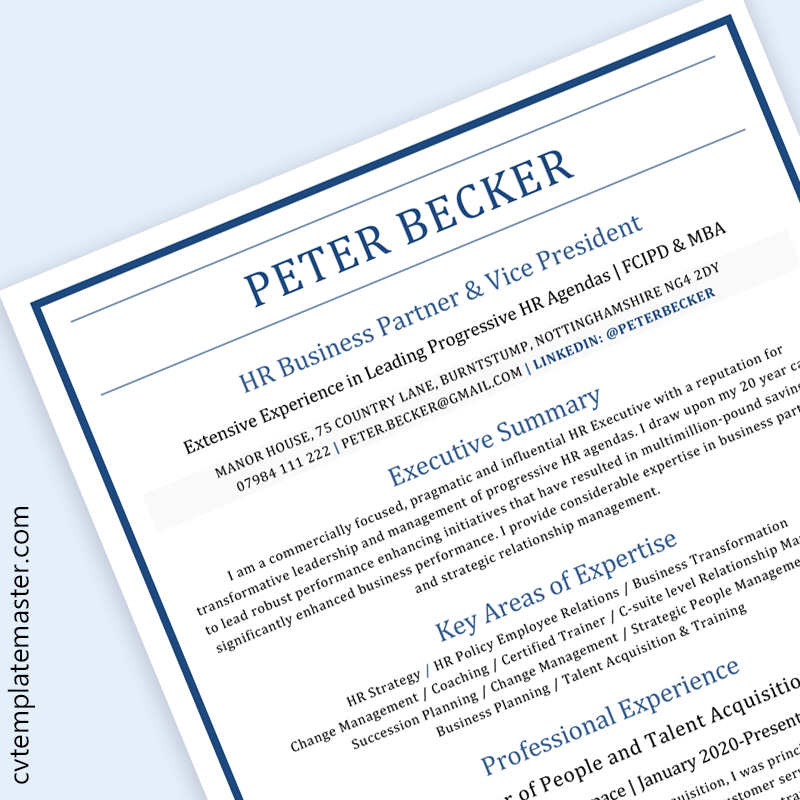Text preview of this CV template:
This is a text-only preview - download the formatted Word file using the link above.
Peter Becker
HR Business Partner & Vice President
Extensive Experience in Leading Progressive HR Agendas | FCIPD & MBA
Manor House, 75 Country Lane, Burntstump, Nottinghamshire NG4 2DY
07984 111 222 | peter.becker@gmail.com
Executive Summary
I am a commercially focused, pragmatic and influential HR Executive with a reputation for transformative leadership and management of progressive HR agendas. I draw upon my 20 year career to lead robust performance enhancing initiatives that have resulted in multimillion-pound savings and significantly enhanced business performance. I provide considerable expertise in business partnering and strategic relationship management.
Key Areas of Expertise
HR Strategy / HR Policy Employee Relations / Business Transformation
Change Management / Coaching / Certified Trainer / C-suite level Relationship Management
Succession Planning / Change Management / Strategic People Management
Business Planning / Talent Acquisition & Training
Professional Experience
Director of People and Talent Acquisition
Downton Aerospace | January 2020-Present
In the capacity as Director for People and Talent Acquisition, I was principally appointed to lead aggressive growth plans for an outsourced engineering, customer service and manufacturing operational units. I led a significant period of change and business transformation, new policies, engagement and established the new internal HR system thereby streamlining payroll, reporting and expenses. I managed a HR function of 40 direct reports and an overall headcount of 2000+.
Key Achievements
- Innovator of the Mental Health and Wellbeing Strategy and structured the company-wide. recruitment programme in response to COVID-19 which increased 200FTE, with working from home onboarding and training.
- Significantly impacted on recruitment and introduction of temporary and freelance specialists to meet seasonal fluctuations.
- Spearheaded the annual pay review process affecting 10,000 employees to timescale and with minimal disruption.
- Led a complex grievance process with no external repercussions and implemented a new performance system roll out across the business.
Executive Vice President / HR Business Partner
Smith Business Services | July 2008 – December 2019
As a Business Partner, I play a key role in providing decisive leadership in relation to developing people plans that support the overall business plan. I partner directly with the wider senior executive team to deliver the HR plans. I delivered the HR strategy which supported the overall business agenda for business growth. I established the HR infrastructure, led talent management, acquisition and succession.
Key Achievements
- Directed the company restructure which further maximised talent, succession planning and identified ten potential leaders who subsequently were repositioned for future business expansion plans.
- Managed the organisational redundancy programme affecting 200, and involved in the closure of 2 business sites and returned a £500K cost saving.
- Drove a highly complex and multifaceted investment programme and successfully TUPE transferred 50+ employees.
- Served as the expert in all aspects of people management and relations; created a new organisational and streamlined structure.
- Focused expertise on the development of the Graduate Development Programme; growing the number of graduates from 15 to 300.
HR Manager & Graduate Trainee
Smith Business Services | September 2003-July 2008
Upon the completion of my degree, I secured a 2-year graduate trainee role covering all aspects of human resource management, recruitment, training, learning and development and employee relations. I performed a generalist HR function across the organisation, including absence management and succession planning.
After my 2-year training, I was seconded to HR Manager and I was then offered a permanent role within six months. My responsibility was for a HR team of ten, including five HR Administrator and five HR Advisors.
Key Achievements
- Rapidly advanced understanding of complex employee relations and provided expert advice to Team Leaders and the wider business.
- Extensive and direct communication with a wide range of internal and external stakeholders including trade unions and the legal team.
- Designed and delivered over 50 training courses further advancing the importance of effective recruitment and compliance.
- Spearheaded HR policies and procedures and strategic human resources initiatives in accordance with new changes in legislation and the strategic objectives of the organization.
Board Positions
- Member of the Local Chain of Commerce (2020-Present)
- Member of the Business Links Network (2017-Present)
Education
MBA
University of London (2018-2020)
MSc (Distinction) Human Resource Management – CIPD Accredited
University of Kent (2003-2005)
First Class (Hons) BSc Business Management with Human Resource Management
University of Surrey (2000-2003)
Affiliations
FCIPD – Fellow Chartered Institute of Personnel Development – 2017-Present
Template details:
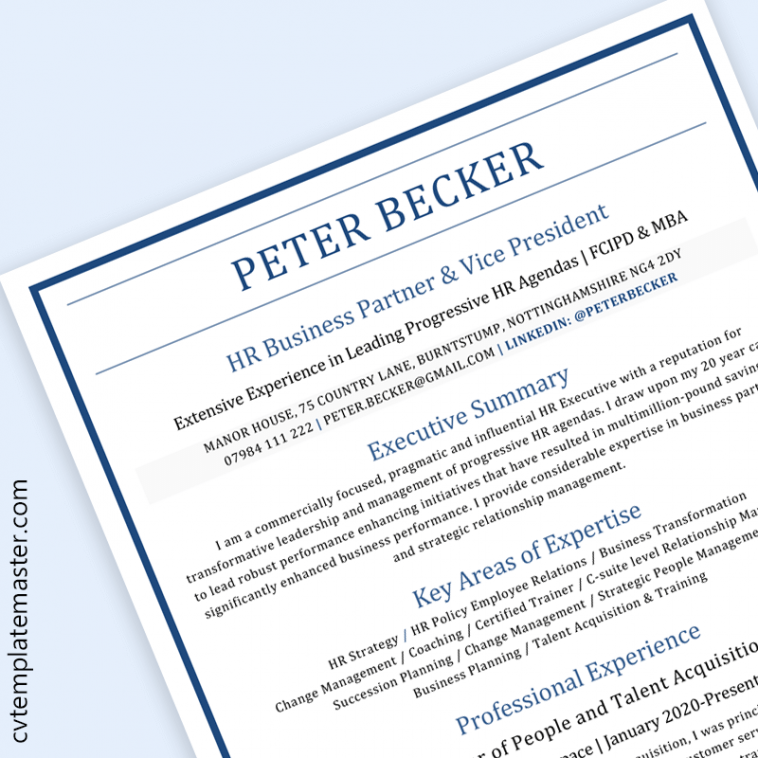
Here’s a full preview of page one of this Executive CV template:
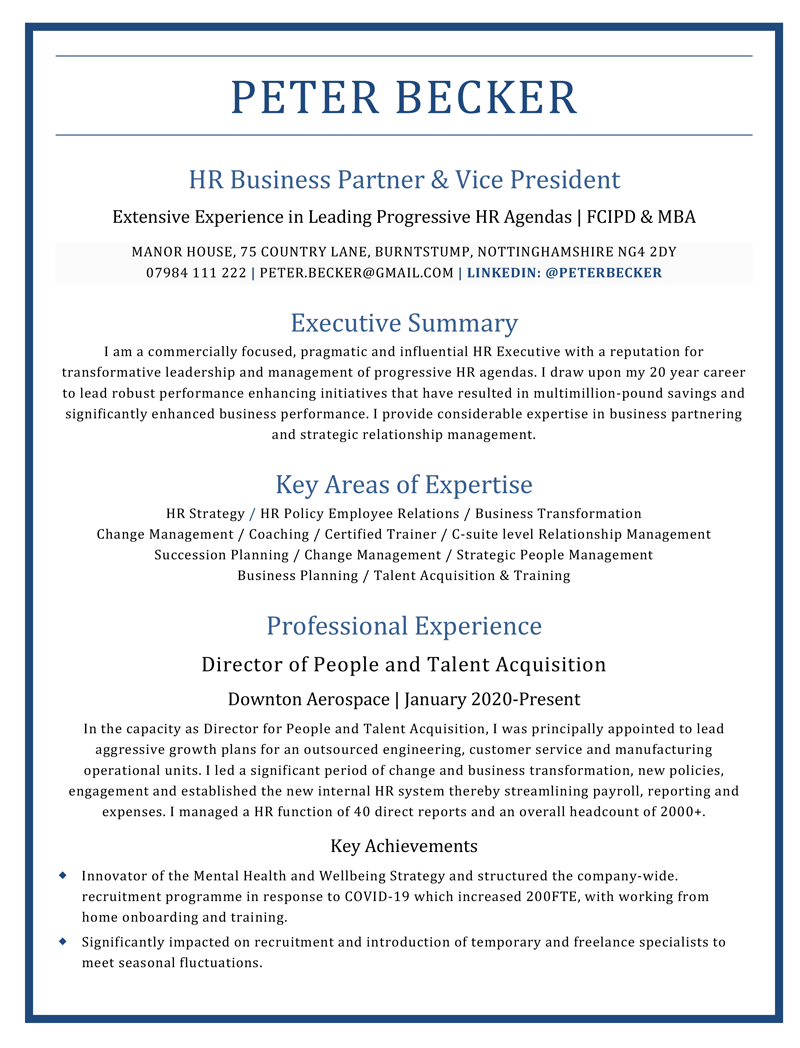
Here’s page two:
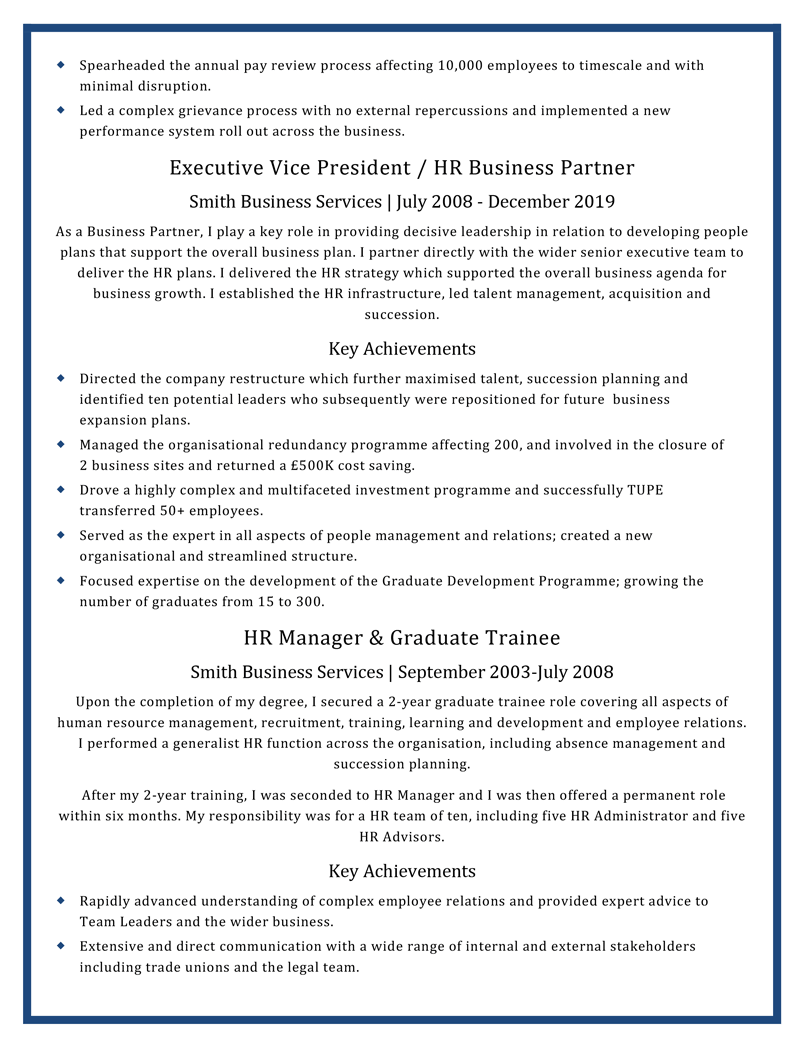
Here’s page three:
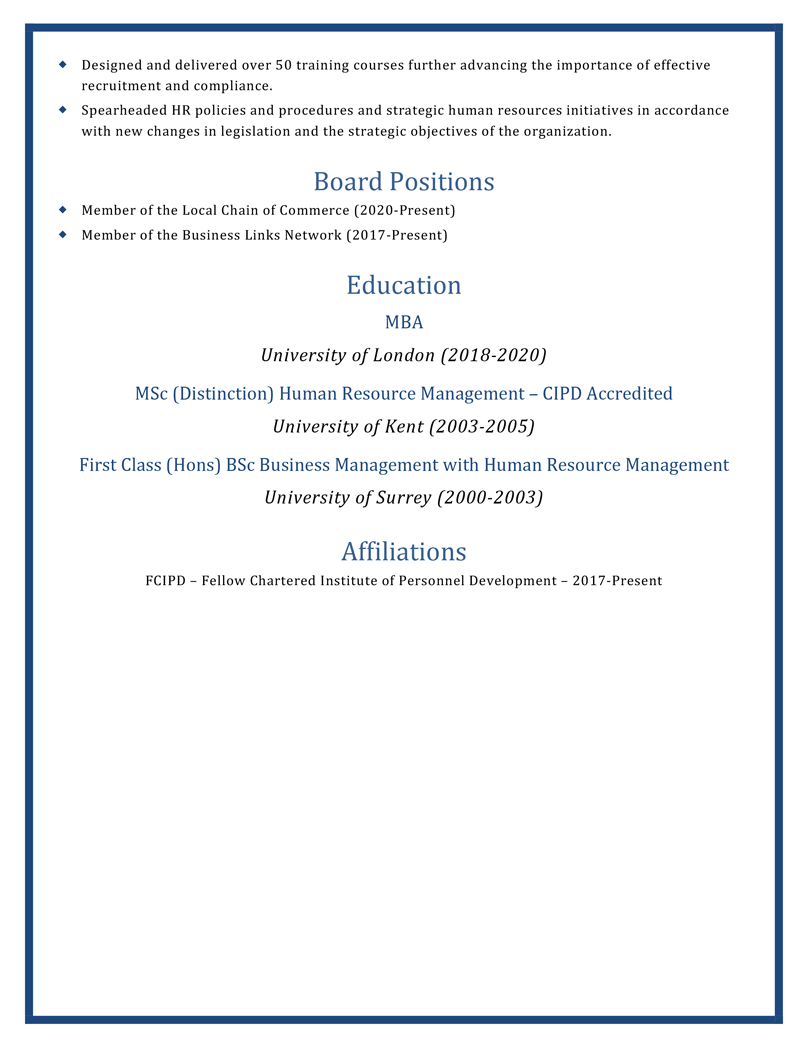
How to write an executive CV
Executive CVs are a little different to a standard CV. In this section we explain the differences and provide a range of guidance on writing an effective Executive CV for the best chance of winning a job interview.
Length
Because you’re applying for a more senior position, you’ll be expected to have more experience in your work history and it’s not unusual for your CV to exceed the normal two page limit. However, keep in mind that a lengthy, text-heavy document does not make for easy reading. Employers have little time to spend on each CV – often just a few seconds – so you still need to be concise.
You’ll see that although our executive CV template spans three pages, it isn’t text heavy. It uses headings and bulleted lists to break up the information effectively, keeping it light and easy-to-read.
Provide more detail in your work history of the roles that are relevant to your target job. Offer less detail for irrelevant roles, noting only the experience and skills that are transferable. You may still feel the need to include these to avoid employment gaps, but for very old irrelevant roles, it is acceptable to either group them (e.g. ‘Waitress, 1991 – 2000, various positions’) or leave them off altogether.
With length a constraint, there’s no better way to offer more detail to recruiters than by developing your LinkedIn profile. LinkedIn has something of a digital CV format in itself, but it allows you to include far more information. In particular, you can create a portfolio section, ask for recommendations and build your endorsements – all of which offer further proof to recruiters that you have the desired skills.
Find out more about building a strong LinkedIn profile here.
Once you’ve created your profile, be sure to include it in a prominent position on your CV – as we have done on our example executive CV template.
Layout
If you’ve been in the same job role for some time, you may not have realised how CVs have changed in modern times. Standards have changed, as have best practices. Scrap any old layout that you’ve been hanging on to and start afresh using a CV that will pass through an Applicant Tracking System. This type of software is used by many recruiters to pre-screen CVs for certain key criteria and quickly filter out unsuitable candidates. However, many older style CV templates cannot be read properly by the software, leading to candidates being rejected unnecessarily.
Our free executive CV template is ATS-friendly and can be downloaded above.
Executive CV Content
Achievements
Whilst an entry-level candidate might simply detail their job titles, responsibilities and qualifications, far more will be expected from an executive. Although the exact skill set will depend on the type of executive role you target, employers generally want to see that you can establish procedures, direct and oversee finances, manage change, lead and consult with staff at all levels, recruit and supervise, analyse, strategize, lower costs and improve performance across the board. It is not enough to simply claim these skills – you need to give evidence of how you have used these skills effectively throughout your career and delivered results.
The most powerful way of providing this evidence is through achievements. These show that you’ve used the skill with a positive impact. You’ll see that in our executive CV template, we use achievements for every position.
This list of action verbs from MIT offers excellent inspiration when thinking about your work achievements.
Keywords
In addition to providing evidence of your skills, you also need to ensure that your content includes any keywords that the employer is looking for. These might be specific skills, qualifications (e.g. ‘MBA’) or experience mentioned within the job advert. Try to mirror the same keywords on your CV – this is especially important if the employer is using ATS software to pre-screen candidates.
Tailoring
It used to be acceptable to send out piles of identical CVs to every suitable vacancy and hope for a few responses. Nowadays it’s expected that every CV you write will be tailored to the specific job specification.
Review the job advert carefully and ascertain what is most important to this employer. For example:
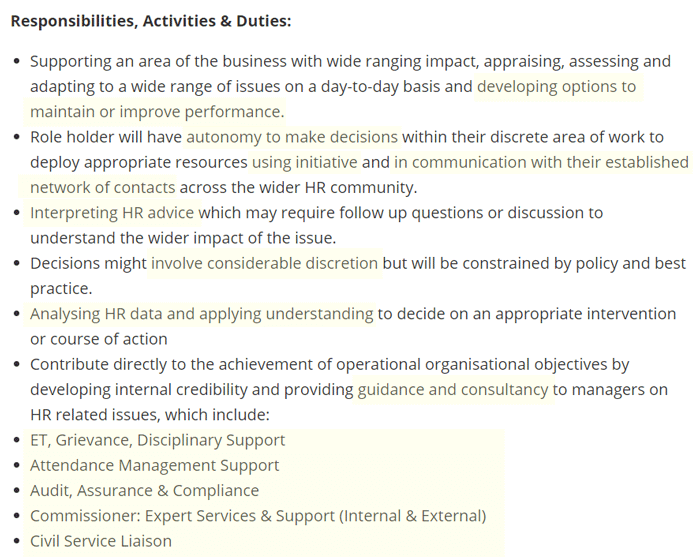
The main concerns for this employer are finding someone who:
- Has experience of making decisions on their own with a large degree of autonomy, within the confines of a best-practice framework.
- Can interpret HR best practice and has excellent knowledge of a range of HR related issues, with the ability to guide other seniors on such topics.
- Can confidently analyse data and use it to guide decisions.
- Can competently use and design systems to maintain or improve performance.
- Has an established network of HR contacts.
If you were responding to this job advert, you would highlight on your CV how you meet these criteria through your experience and achievements.
USP
In a highly-competitive job market, having a unique selling point – a USP – is essential. USPs are typically used to market products. They tell consumers how the product can benefit them in some way that other similar products cannot. For example, the USP for M&Ms is:
“The milk chocolate melts in your mouth, not in your hand.”
Think of USPs in terms of benefits rather than features. So for example, one of your features might be “I have 15+ years of work experience.” Whilst this is a positive feature, it isn’t necessarily a benefit (I could work as a waiter in a restaurant for 15 years but I might still be a lousy waiter).
To identify your USP, consider:
- What skills, experiences and knowledge fields do you have that stand out?
- Which ones are unique to you (or difficult to find)?
- If you can’t find one unique thing that shines through, perhaps you can find a unique and uncommon combination of things?
Source: Coburg Banks
As James Ball of Coburg Banks explains,
Instead of claiming ‘I can do X, Y and Z’ you should focus on what that means for the employer; ‘I can do X, Y and Z which means that I’ll save you time, money and effort’.
The Coburg Banks article here is a really good guide to developing your USP.
Inappropriate details
It used to be fairly common to include details on your CV such as your marital status and age. Nowadays, best practice dictates that these should be avoided at all costs. Leave off any protected characteristics: age, disabilities, gender, gender reassignment, marital or civil partnership status, pregnancy or maternity, race, religion or belief. For all but a small handful of jobs, this information is irrelevant to the employer’s decision over whether or not to offer you an interview. Further, they can attract discrimination.
Summary
- Choose an ATS-compliant CV layout like the executive CV template on this page.
- Use the job advert to find out what’s most important to the individual employer and write a tailored CV for each job vacancy.
- Use the same keywords that the employer uses within your CV, for ATS screening.
- Develop a USP, focusing on benefits rather than features.
- Include evidence that you can deliver results rather than just carry out responsibilities.
- Provide more detail for the most relevant roles, focusing on experience and achievements that meet your target employer’s requirements.
- Avoid generic cliché phrases – instead, show what you can do.
- Leave off unnecessary information (very old irrelevant roles, or protected characteristics).
- Develop your LinkedIn profile and include your LinkedIn handle in a prominent position on your CV.
NB: This CV template was originally published 11th February 2016 and has been completely updated for 2021.
